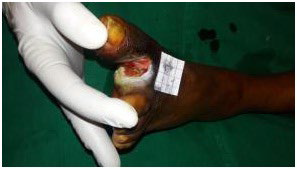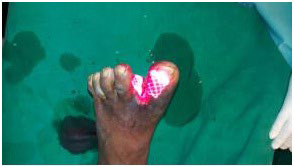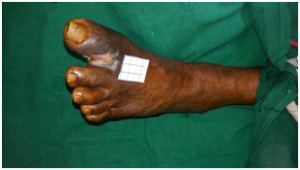1. Yazdanpanah L, Nasiri M, Adarvishi S. Literature review on management of diabetic foot ulcer. World J Diabetes. 2015; 6(1): 37-53. doi: 10.4239/wjd.v6.i1.37
2. Mavrogenis AF, Megaloikonomus PD, Antoniadou T, Igoumenou VG, Panagopoulos GN, Dimopoulos L, et al. Currentconcepts for the evaluation and management of diabetic footulcers. EFFORT Open Rev. 2018; 3(9): 513-525. doi: 10.1302/2058- 5241.3.180010
3. Karu TI. Low-power laser therapy. In: Vo-Dinh T, ed. Biomedicalphotonics Handbook. London, UK: CRC Press, 2003: 7-20.
4. David CBG. Therapeutic Lasers. Theory and Practice. London, UK: Churchill Livingstone; 1994.
5. Palagi S, Severo IM, Menegon DB, Lucena AF. Laserterapiaemúlceraporpressão: avaliaçãopelas pressure ulcer scale for healing e nursing outcomes classification. Rev EscolaEnfermagem USP. 2015; 49(5): 826-833. doi: 10.1590/S0080-623420150000500017
6. Andrade FSSD, Clark RMO, Ferreira ML. Effects of low-level laser therapy on wound healing. Rev Col Bras Cir. 2014; 41(2): 129- 133. doi: 10.1590/s0100-69912014000200010
7. Lichtenstein D, Morag B. Low-level laser therapyin ambulatory patients withvenous stasis ulcers. Laser Therapy. 1998; 11: 71-78. doi: 10.5978/islsm.11.71
8. Karu, T. Molecular mechanism of therapeutic effect of low intensity laser irradiation Dokl Akad Nauk SSSR. 1986; 291: 1245- 1249.
9. Karu, T. Photobiology oflow-power laser effects. Health Phys. 1989; 56: 691-704. doi: 10.1097/00004032-198905000-00015
10. Wilden, L., Karthein, R. Import of radiationphenomena of electronsand therapeutic low-levellaser in regard to themitochondrial energytransfer. J Clin Laser Med Surg. 1998; 16: 159-165. doi: 10.1089/clm.1998.16.159
11. Stadler I, Evans R, Kolb B, Naim JO, Narayan V, Buehner N, et al. In vitro effects oflow-level laser irradiation at 660 nm on peripheral bloodly mphocytes. Lasers Surg Med. 2000; 27: 255-261. doi: 10.1002/1096-9101(2000)27:3<_x0032_55:_x003a_aid-lsm7>3.0.co;2-l
12. Yu W, Naim JO, Lanzafame RJ. Effects of photostimulation on wound healing in diabetic mice. Lasers Surg Med. 1997; 20: 56-63. doi: 10.1002/(sici)1096-9101(1997)20:1<_x0035_6:_x003a_aid-lsm9>3.0.co;2-y
13. Yu W, Naim JO, Lanzafame RJ. The effect of laser irradiation on the release of bFGF from 3T3 fibroblasts. Photocem Photobiol. 1994; 59: 167-170. doi: 10.1111/j.1751-1097.1994.tb05017.x
14. Saperia D, Glassberg E, Lyons RF, Abergel RP, Baneux P, Castel JC, et al. Demonstration of elevatedtype I and type III procollagen mRNA levelsin cutaneous wound streated with helium-neonlaser: Proposed mechanismfor enhanced wound healing. Biochem Biophys Res Commun. 1986; 138: 1123-1128. doi: 10.1016/ S0006-291X(86)80399-0
15. Schindl A, Schindl M,Schindl L, Jurecka W, Hönigsmann H, Breier F, et al. Increased dermal angiogenesis after low-intensity laser therapy for a chronic radiation ulcer determined by avideo measuring system. J Am Acad Dermatol. 1999; 40: 481-484. doi: 10.1016/s0190-9622(99)70503-7
16. Priyadarshini LMJ, Kishore Babu EP, Thariq AI. Effect of low level laser therapy on diabetic foot ulcers: A randomized control trial. Int Surg J. 2018; 5(3): 1008-1015. doi: 10.18203/2349-2902. isj20180821
17. Rocha Júnior AM, Vieira BJ, Andrade LCF, Aarestrup FM. Effects of low-level laser therapy on the progress of wound healing in humans: The contribution of in vitro and in vivo experimental studies. J vasc bras. 2007; 6: 257-265. doi: 10.1590/ S1677-54492007000300009








